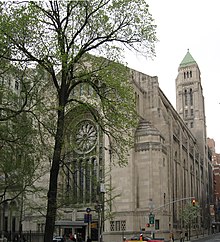User:JPRiley/Butler
| This is not a Wikipedia article: It is an individual user's work-in-progress page, and may be incomplete and/or unreliable. For guidance on developing this draft, see Wikipedia:So you made a userspace draft. Find sources: Google (books · news · scholar · free images · WP refs) · FENS · JSTOR · TWL |
Charles Butler | |
|---|---|
| Born | October 14, 1870 |
| Died | June 4, 1953 (aged 82) |
| Nationality | American |
| Occupation | Architect |
| Practice | Morris, Butler & Rodman; Butler & Rodman; Butler, Rodman & Oliver; Robert D. Kohn and Charles Butler |



Charles Butler FAIA (1870–1953) was an American architect in practice in New York City from 1899 to 1953.
Life and Career
[edit]Charles Butler was born October 14, 1870 in Scarsdale, New York to Benjamin Franklin Butler Jr., son of former United States Attorney General Benjamin Franklin Butler, and Ellen Grenville (Parker) Butler, daughter of surgeon Willard Parker. He was educated at Columbia University and the École des Beaux-Arts in Paris, earning his diplôme in 1897.[1] Upon his return the the United States he began working for the firm of Howard & Cauldwell in New York City, but in 1899 he entered private practice, forming the firm of Morris, Butler & Rodman with Benjamin Wistar Morris and Cary S. Rodman. Morris withdrew the following year, but Butler and Rodman worked together until Rodman's death in 1911.[1] Butler continued the firm under the name of Butler & Rodman until 1930, though beginning in 1922 he was also associated with Robert D. Kohn, a business agreement which was formalized in 1930.[2]
Butler was best known as an architect of large institutional projects, especially hospitals. Major works in the United States include the Harriet Lane Home for Invalid Children in Baltimore, completed in 1912, and the United States General Services Administration Building in Washington, D.C., completed in 1917. During World War I Butler was retained as a consultant to the French Ministry of War, for which he designed military hospitals. Among these was one permanent facility, the Hôpital d'instruction des armées Percy in Clamart, completed in 1920.[1] A major work in association with Kohn is the Temple Emanu-El, completed in 1929.[2]
Butler joined the American Institute of Architects in 1904, and was elected a Fellow in 1918. In 1930 he was awarded an honorary Doctor of Letters by Columbia University and in 1931 an honorary Doctor of Science from the Rensselaer Polytechnic Institute.[3] Butler was also affiliated with the National Council of Architectural Registration Boards, serving as president for the year 1937–38.[4]
Personal life
[edit]Butler was married in 1917 to Elizabeth Van Nostrand Marvin.[1] He died June 4, 1953 in New York City.[3]
Architectural works
[edit]Morris, Butler & Rodman, 1899–1900
[edit]- 1900 – Clyde Fitch house,[a] 113 E 40th St, New York City[5]
- 1901 – John D. Archbold mausoleum, Sleepy Hollow Cemetery, Sleepy Hollow, New York[6]
- 1901 – Bajnotti Fountain,[b] Burnside Park, Providence, Rhode Island[7]
Butler & Rodman, 1900–1905 and 1906–1930
[edit]Butler, Rodman & Oliver, 1905–1906
[edit]- 1905 – Vivant Machin bakery, 316 E 59th St, New York City[8]
Notes
[edit]- ^ Demolished.
- ^ Designed by Enid Yandell, sculptor, with Morris, Butler & Rodman as architects for the basin and as supervising architects.
References
[edit]- ^ a b c d "Butler, Charles" in ' (): 576.
- ^ a b Robert D. Kohn and Charles Butler, AIA Historical Directory of American Architects, no date. Accessed January 13, 2023.
- ^ a b "Charles Butler, An Architect, 82" in New York Times, June 5, 1953, 27.
- ^ Charles Butler FAIA, National Council of Architectural Registration Boards, no date. Accessed January 13, 2023.
- ^ American Architect and Building News 68, no. 1273 (May 19, 1900): xi.
- ^ "A Beautiful Memorial at Sleepy Hollow" in Stone 24, no. 4 (April, 1902): 314=316.
- ^ "The Brown Fountain," Providence Journal, June 27, 1901, 4.
- ^ Real Estate Record and Builders Guide 75, no. 1934 (April 8, 1905): 792.

